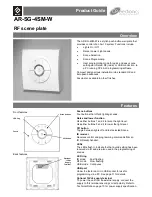
© Koninklijke Philips Electronics N.V. 2005. All rights reserved.
User manual
Rev. 01 — 15 August 2005
16
3.1 Summary of system control block functions
The System Control Block includes several system features and control registers for a
number of functions that are not related to specific peripheral devices. These include:
•
Crystal Oscillator
•
External Interrupt Inputs
•
Miscellaneous System Controls and Status
•
Memory Mapping Control
•
PLL
•
Power Control
•
Reset
•
VPB Divider
•
Wakeup Timer
Each type of function has its own register(s) if any are required and unneeded bits are
defined as reserved in order to allow future expansion. Unrelated functions never share
the same register addresses
3.2 Pin description
shows pins that are associated with System Control block functions.
UM10139
Chapter 3: System Control Block
Rev. 01 — 15 August 2005
User manual
Table 5:
Pin summary
Pin name
Pin
direction
Pin description
X1
Input
Crystal Oscillator Input - Input to the oscillator and internal clock
generator circuits
X2
Output
Crystal Oscillator Output - Output from the oscillator amplifier
EINT0
Input
External Interrupt Input 0 - An active low/high level or
falling/rising edge general purpose interrupt input. This pin may be
used to wake up the processor from Idle or Power-down modes.
Pins P0.1 and P0.16 can be selected to perform EINT0 function.
EINT1
Input
External Interrupt Input 1 - See the EINT0 description above.
Pins P0.3 and P0.14 can be selected to perform EINT1 function.
Important: LOW level on pin P0.14 immediately after reset is
considered as an external hardware request to start the ISP
command handler. More details on ISP and Serial Boot Loader can
be found in "Flash Memory System and Programming" chapter on
page 291.
















































